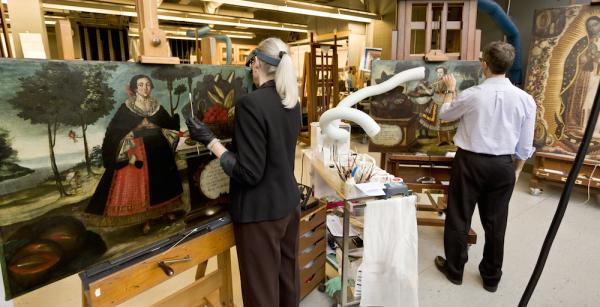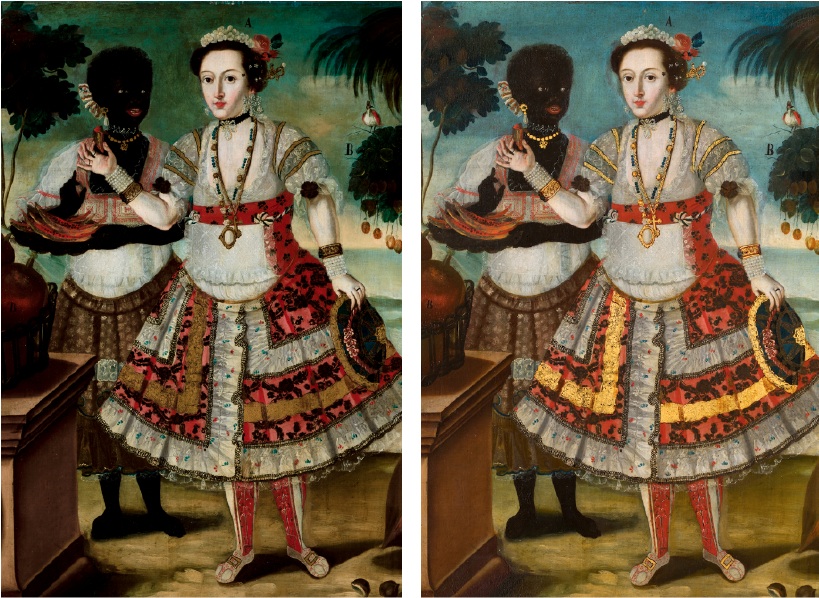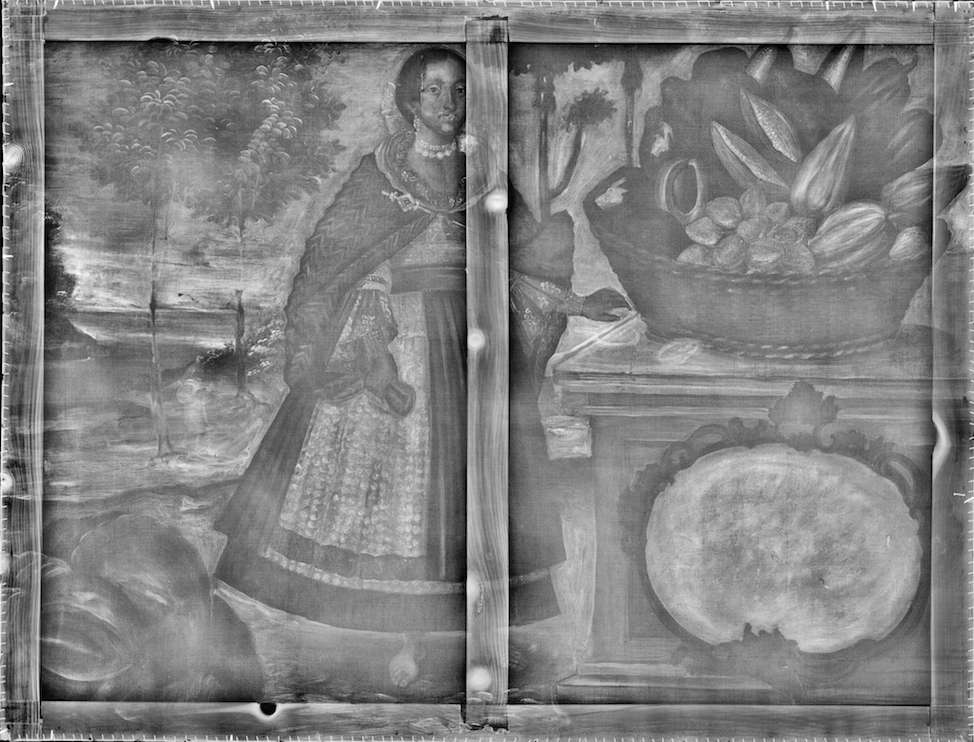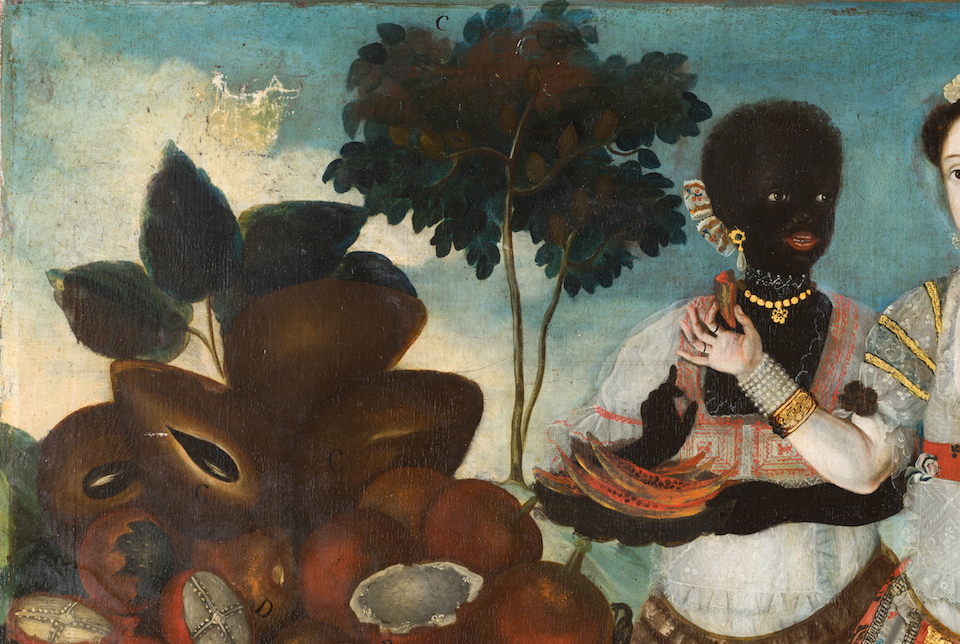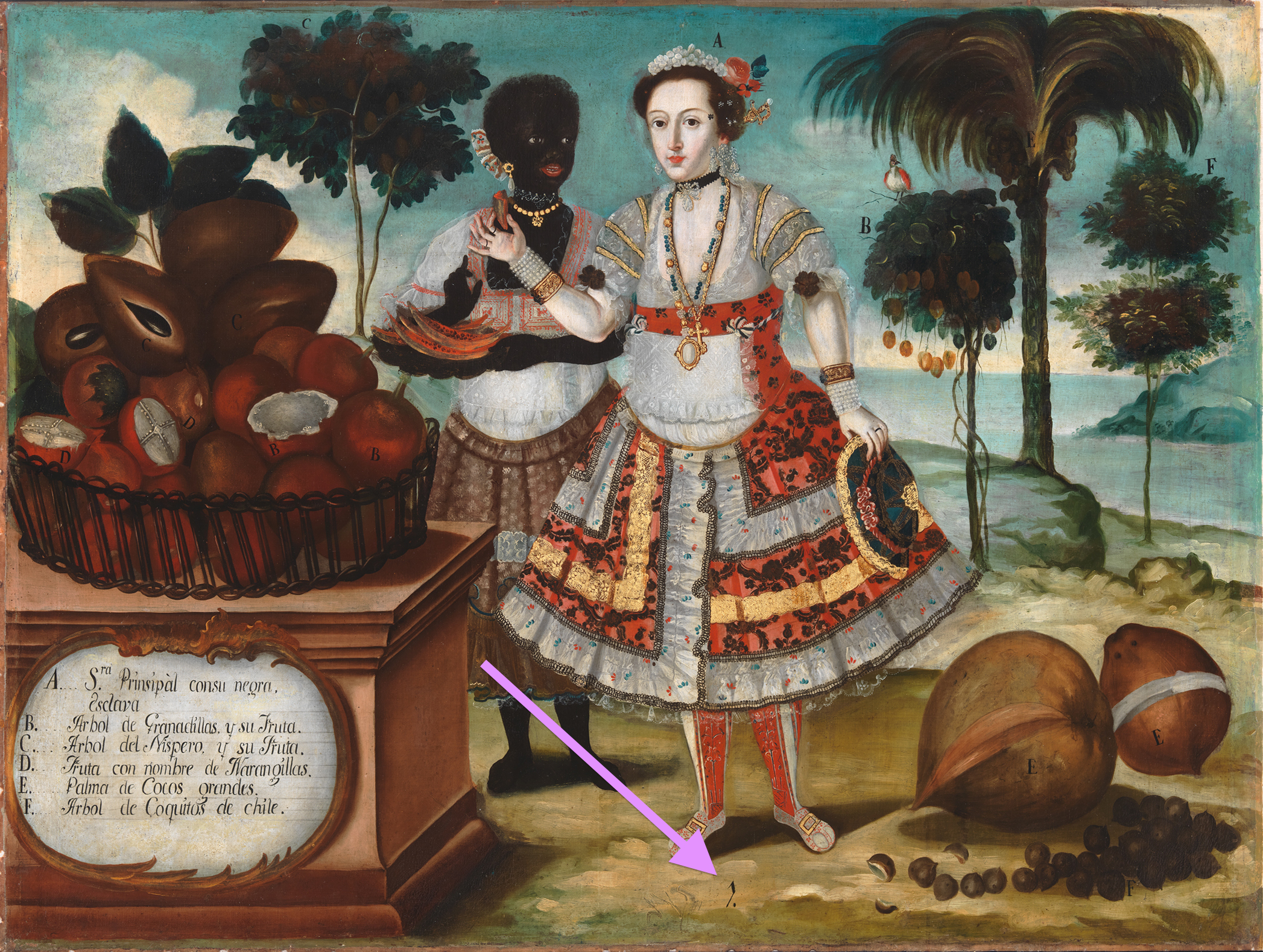In May 2014 LACMA acquired two important paintings by Vicente Albán, an 18th-century master from Ecuador. Over the past few months the museum’s painting conservators and scientists have carefully examined the works, using various tools such as high magnification, X-radiography, and infrared reflectography. Before undertaking their restoration, Ilona Katzew, curator and department head of Latin American art, and Joseph Fronek, head, Paintings Conservation, traveled to Spain to look at comparative paintings at the Museo de América in Madrid. What follows is a conversation between them about this remarkable new addition.
Ilona Katzew: What was your first impression of the two Ecuadorean paintings when they first came to the lab?
Joseph Fronek: The first time I saw the paintings was in New York with you before we bought them. I immediately felt that they were so different and interesting. They had presence. I was intrigued with the fine detail of the figures and plants versus the looser application of paint in the sky and landscape. Beneath a dirty varnish I felt the condition was good, which is why they came across so well: colors seemed preserved and the gold work was impressive and mostly intact.
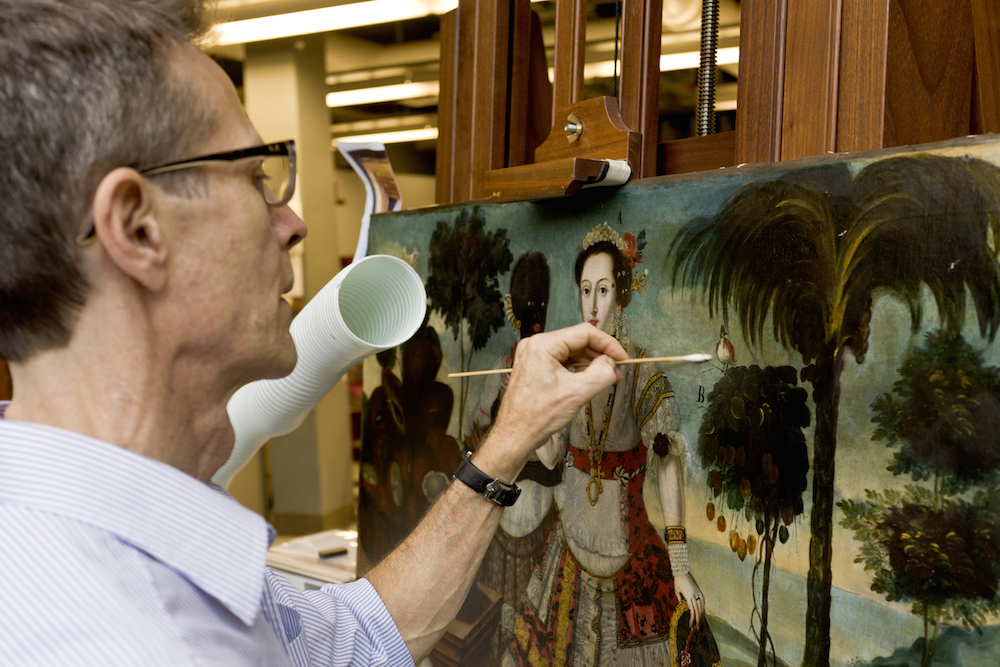
IK: Could you briefly describe what the restoration process consisted of and what your overall goals were?
JF: First we evaluated the paintings. Cleaning would be necessary to bring out the colors and space. Some areas of the paintings, such as the flesh and costume of the noble woman, had been selectively cleaned in the past, but the remaining yellowed varnish and the old discolored restorations had to be removed. Past cleaning went a little too far in some areas, and these bright spots would need to be toned back with a thin, translucent glaze. A careful cleaning should always preserve the patina or aged surface of the original paint.
In addition, the paintings had been strengthened by lining; that is, another canvas was adhered to the reverse of the original picture with an adhesive (in this case, wax). Then the paintings were tacked onto stretchers that are about half an inch smaller in width than the painted images. The pictures needed to be restored to their original size, which is the same size as the paintings we saw in Madrid. To accomplish this, it would be necessary to remove the old linings and stretch the paintings on new stretchers of the appropriate size.

IK: One of the aspects that immediately stood out to me was the bluefish hue of the avocado fruits. Could you explain what accounts for this color alteration? Did you conduct any pigment analysis, and were any of the results surprising? I am especially intrigued by the metallic silver paint applied to the dress of the noble woman and the large pin that fastens the black mantle of the indigenous figure (click on the image above to enlarge).
JF: The blue of the avocado and some leaves is not an original appearance. To create the color green, a blue pigment (Prussian blue or less likely indigo in these paintings) was mixed with yellow, in this case orpiment. Some yellows deteriorate and fade, leaving blue as the dominant color. The original, intense green of the leaves can be seen in the lower left edge of the painting of the Indian woman.
The intricate fringe and floral pattern on the noble woman’s skirt are made of silver that has turned black. The conservation scientists discovered that the silver became silver sulfide, and the discoloration cannot be reversed. Nevertheless the intricacy of the patterns is incredible, and one must try to imagine how the costume would have appeared with the original silver. The same happened with the pin holding the Indian woman’s mantle, which was once bright silver.
IK: As you note, you worked closely with the museum’s team of conservation scientists and also had the two paintings X-radiographed. Aside from discovering that much of the black in the noble woman’s dress is actually tarnished silver, what else did these studies reveal that is not readily apparent to the naked eye?
JF: The most amazing finding was the chevron design in the mantle of the Indian woman. The black costume appeared to have no delineation. The X-radiograph, however, shows this chevron pattern as well as pleats in the black cloth over her skirt. The X-radiographs also show that the artist adjusted the left sides of the noble woman and the Indian woman. Both figures were first placed slightly to the left of where they stand now so that the noble woman was closer to her basket of produce, and the Indian woman was further away from hers.
These adjustments seem to have balanced the compositions, and are clearly visible in the X-radiographs. For example, there is a “shadow,” or dark form, along the left side of the Indian woman’s mantle that even has a rippled outline. To the left of the noble woman’s head, the X-radiograph shows a dark form and a white, dense area, which represents a heavier element pigment such as lead white. The shadow seems to represent the dark hair and the light spot the pale flesh. These pentimenti (traces of an underlying image corrected by the artist) may be partially visible on the surface of the painting in strong raking light.
X-rays can also disclose damages. For example, there was extensive later overpaint in the upper left sky of the painting of the noble woman. Now discolored it did not match the color of the rest of the sky at all. The X-radiograph also revealed a damage about the size of a quarter beneath the restoration. And after we removed the discolored restoration, we discovered that the overpaint covered a cloud, which reminded me of the one in the Madrid version of this same subject.
IK: LACMA's paintings, as you know, are inscribed in the lower center with the numeral 1 and originally formed part of a set of six canvases (the other four are in a private collection); the set remains unsigned. There is also a second complete set (inscribed with the numeral 2) in the collection of the Museo de América in Madrid, Spain, which is signed by Vicente Albán.
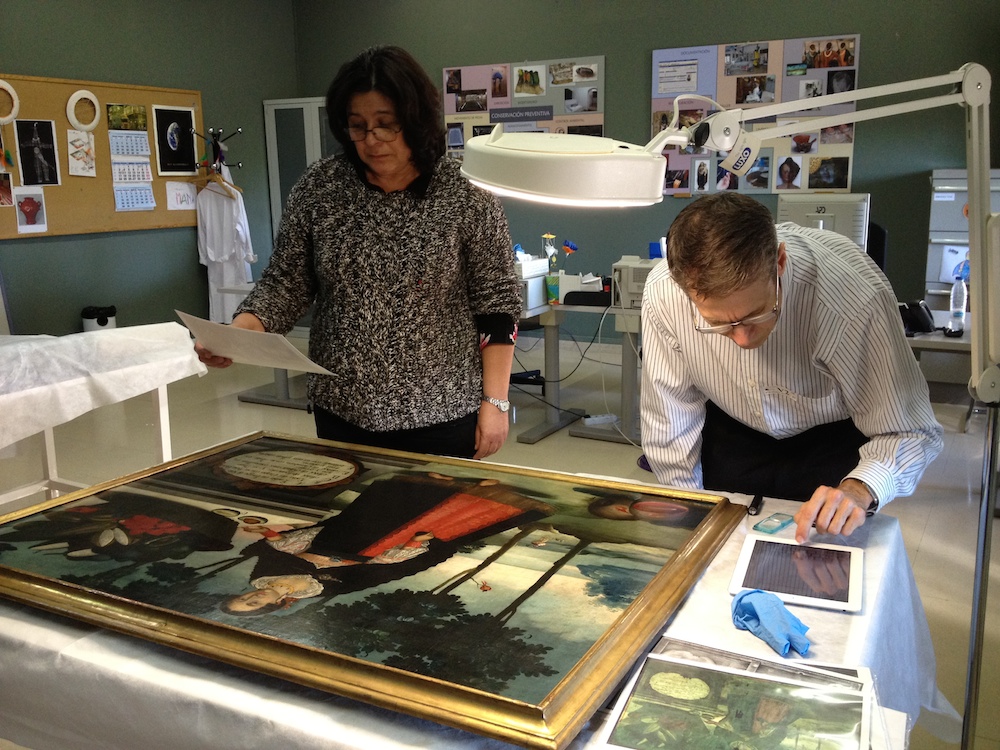
We recently traveled together to Madrid to examine that set. Could you articulate some of your thoughts following the comparison of both series?
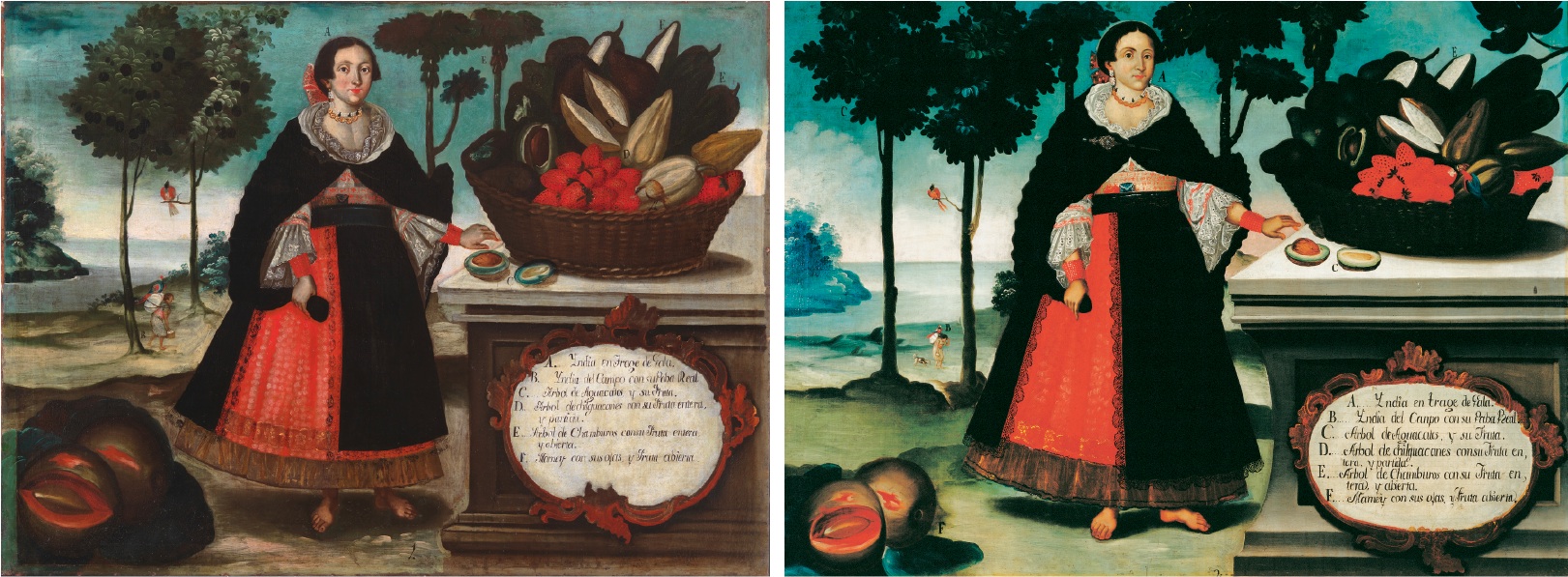
JF: The images are very similar, but there are significant differences. The figures in LACMA’s paintings are a bit stocky in comparison to the elongated figures in the Madrid paintings. In general, I think that the figures in the Los Angeles paintings have more weight and more volume in space. They seem more solid. The details such as the lace of the Indian woman’s blouse are a different design and more intricate in the Madrid painting (click on the image above to enlarge).
In addition, in the Los Angeles paintings, the horizon lines seem high, and the landscape therefore appears tilted up and flattened while in the Madrid paintings, it is the opposite. It is as if the Madrid and the Los Angeles paintings have a different concept of space. Also, the placement and numbers or shapes of trees and clouds are somewhat different in the two paintings, and there are many other minor differences that we could point out. Overall it seems to me that the Los Angeles paintings were done earlier and the Madrid paintings are elaborations.
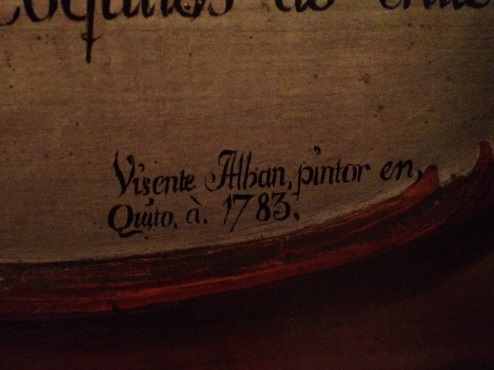
IK: These are very intriguing observations, which make me wonder if the Madrid set, though signed by Vicente Albán (active 1767–96), was created with workshop assistance. But we also know, for example, that Vicente collaborated with his brother, Francisco Albán (1742–88), on other commissions in Quito, Ecuador. Given the differences between both sets that you point out, do you think they may be by different hands?
JF: While the techniques and application of paint seem very similar the styles of the two sets are different as I discuss above. This idea about authorship is certainly intriguing. There does seem to be a different mind at work in the two sets. As for workshop, I wonder if the landscape in each painting could have been done by one artist and then the elaborate figures by another. This is just my immediate response. It would take more study of other paintings by the artists to give any kind of a serious explanation, of course.
IK: Yes, I agree that this is an important fact, but one that we cannot definitively solve at the moment. There is still so much more that we need to learn first about the work of the Albán brothers. And generally one of the greatest challenges of the field is not having a more complete picture of the body of work of many artists. But the differences between both sets do raise important questions about the significance of creating replicas and the value accorded to these copies. I suspect that copies were often valued even more than the so-called originals, or at the very least seen as an opportunity to make important adjustments and continue experimenting.



